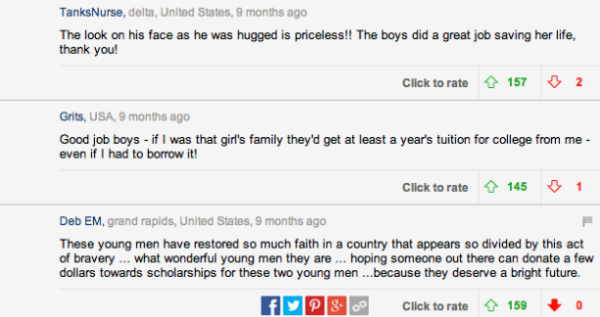How Playing Devil’s Advocate Will Improve Your Content
When you finish writing something, it’s tempting to sit back in your desk chair and beam — but that won’t result in great content. What you really have to do is take a walk, come back with a fresh eye, and tear your content apart. This is the only way to make content that’s interesting, […]
When you finish writing something, it’s tempting to sit back in your desk chair and beam — but that won’t result in great content. What you really have to do is take a walk, come back with a fresh eye, and tear your content apart. This is the only way to make content that’s interesting, accurate, and share-worthy.
The best way to develop this critical eye is to play Devil’s Advocate. You might be thinking, “But I just wrote a very accurate, respectable piece of content I’m proud of. Why would I have any criticisms of it if I did my best?” Well, when you wrote the content, you were writing it through your own eyes. You were writing it with the client and audience in mind (hopefully).

image used by permission of Shutterstock.com
And there’s nothing wrong with that. In fact, it’s encouraged! But before you pass it along to publishers, you have to take on the perspective of your biggest critic. This will help you find every hole, every vague sentence, every unsupported fact. It’ll make your piece as strong as possible.
So, how do you become the best Devil’s Advocate? Begin by asking yourself these tough questions:
1. How Do You Know The Information Is Accurate?
If you’ve ever clicked through the comment section of any informative article, you’ve probably seen remarks about how the sources of the data weren’t accurate enough to make the claims the content was making. But even if the source is great, it still might not be the best information, and people will be ready to pounce if they spot this. Consider these three things:
- Is The Information You Sourced Up-To-Date?
This doesn’t necessarily mean it has to have been published yesterday, but your data’s timeliness should support your conclusion.
For example, if you’re saying that now is the best time to have a dog because pet owner costs are down, but your sources are from 2010, you can’t be sure that now actually is the best time, as it’s 2014.
Keep an eye on this, because your content will lose credit if you don’t have solid factual support. The only time “old” facts are acceptable (over a year old) is if they’re the most recent statistics on a given subject (and then please indicate this) or if they’re being used in comparison to current stats.
- Is The Information From Credible, Respected Sources?
This one’s more obvious, but if your data is from a website people don’t trust, they won’t trust your piece, either. When you’re unsure of a source, ask yourself, “Do I know that this website fact-checked their information? Do they have anything at stake?” If your answer to these questions is “no,” then avoid the source at all costs.
Examples of good sources include .govs, .edus, and even many .orgs. The latter usually has to watch out for their brand’s reputation, which means they won’t want any inaccuracies on their sites (though watch out for some PR spin). Any sites that have no reputable backing behind them might not be the best go-tos for information.
- Is Your Data Sourced In An Easy-To-Find Way?
If you’re stating any facts, especially data-based facts, that aren’t (properly) cited, readers will immediately become suspicious. If they disagree with your point, they can call out your argument by saying the sources are unknown, and then your whole piece falls apart.
Cite your facts, and cite them so they’re easy to find (not size 10 font and only visible after scrolling for 20 minutes). If you run surveys to include your own data (like on CrowdFlower or SurveyMonkey), make sure to have a sample size of at least 1,000 people — many publishers don’t accept any less than that — and include this sample size information in your content.
Facts and statistics are crucial for valuable content. Make sure your information is reliable and trustworthy, because without a solid foundation in verified fact, everything else you write will be invalidated.
2. But What About _______?
This question is a little more vague, because it can take on many forms, but a lot of the time it’s about methodology or context. The best way to think of examples of this question is to get in the mind of your content’s biggest critic — someone trying to poke holes in your thesis.
You’ve undoubtedly seen comments like the ones above before. So let’s work with a hypothetical example: Say you’re writing a piece about how a city is safer recently than it has been in previous decades. Here are some sample contentious questions you can ask yourself:
- You only took into account ______ (ex. homicide rates). What about ______ (ex. overall violent crime rates, prison population, etc.)?
- What if violent crime is down overall because certain areas have dramatically improved and other areas are the same — or even worse?
- But how is the city doing compared to other cities in the state? Other cities in the country? Is the improvement significant or just a fluke?
Be sure to address every relevant question that can be posed and provide an answer in your content.
However, don’t go too crazy by answering off-topic questions. If your tone is supported by fact, and you’ve covered all of your bases, you can present an air-tight article, infographic, or video. Your readers will appreciate how thorough you were in your research and explanations and feel they’ve read something of value.
3. Yeah, Well, Who Cares?
Ouch. Not a question you ever want to hear as a content producer, so it’s not exactly easy to ask yourself. But you have to ask, as this is the most important question of all. If you don’t have a confident answer, you may as well go back to the blank Word document and make another Starbucks run.
To really break down this question, you have to examine the significance of your content. What kind of value is it offering? If it’s not doing everything on this checklist, you might be in trouble:
- Is It Evoking An Emotion In Your Readers?
Emotions are what allow people to connect to words. Emotions are what cause people to share articles and images with others. Emotions form the basis of the human experience. So, yeah, they’re important. If your content isn’t able to provoke any of the emotions that can cause virality, you may want to rethink your approach.
- Is It Supplying People With Knowledge That They Want?
The key word here is “want.” We have to convince readers that our content is worth their time, and we do this by making it very quickly clear that reading this content will benefit them. Indicate that there’s a payoff in the headline, and the first sentence, and maybe even again in the first paragraph. And then, most importantly, we have to deliver on our promise in order to acquire a loyal audience.
- Is It Targeting A Specific Audience?
If it’s not, start over. You need to have your ideal reader in mind so that your content is tailored appropriately. An article about retirement funds will turn out differently if you’re targeting 20- and 30-somethings on Reddit than if you’re targeting parents over the age of 40. Keeping your ideal audience in mind will automatically make your content more specific and relevant, increasing the chances for engagement.
If you can defend your content against these three questions, you can be confident that you’re producing strong, comprehensive content for your audience. The more work you put into crafting your articles, infographics, and other media up front, the more your content will be worthy of readers’ time and attention.
Opinions expressed in this article are those of the guest author and not necessarily MarTech. Staff authors are listed here.
Related stories
New on MarTech


